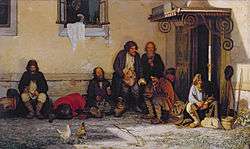Zemstvo

The zemstvo (Russian: Земство; IPA: [ˈzʲɛmstvə], plural zemstva)[1] was a form of local government that was instituted during the great liberal reforms performed in Imperial Russia by Alexander II of Russia. The idea of the zemstvo was elaborated by Nikolay Milyutin, and the first zemstvo laws were put into effect in 1864. After the October Revolution of 1917, the zemstvo system was shut down and replaced by a system of workers' councils.
The system of local self-government in the Russian Empire was presented at the lowest level by mir and volosts and was continued, so far as the 34 Guberniyas of old Russia are concerned,[2] in the elective district and provincial assemblies (zemstvos).
These bodies, one for each district and another for each province or government, were created by Alexander II in 1864. They consisted of a representative council (zemskoye sobranye) and of an executive board (zemskaya uprava) nominated by the former. The board consisted of five classes of members:
- large landed proprietors [nobles owning 590 acres (2.4 km2) and over], who sat in person
- delegates of the small landowners, including the clergy in their capacity of landed proprietors
- delegates of the wealthier townsmen
- delegates of the less wealthy urban classes
- delegates of the peasants, elected by the volosts[3]
The nobles were given more weight in voting for a zemstvo, as evidenced by the fact that 74% of the zemstvo members were nobles, even though nobles were 1.3% of the population. Even so, the zemstvo allowed the greater population to have a say in how a small part of their lives was to be run.
The rules governing elections to the zemstvos were taken as a model for the electoral law of 1906 and are sufficiently indicated by the account of this given below. The zemstvos were originally given large powers in relation to the incidence of taxation and such questions as education, medical relief, public welfare, food supply, and road maintenance in their localities, but they were met with hostility by radicals, such as the Socialist Revolutionary Party and the nihilists, who believed the reforms were too minor. These powers were, however, severely restricted by Alexander III (law of 25 June [O.S. 12 June] 1890); the zemstvos were then subordinated to the governors, whose consent was necessary for each decision. The governors had drastic powers of discipline over the members.
Despite all these restrictions, during the 50 years of the zemstvos, they succeeded in solving properly many problems of general education, public medical service, means of transportation and agronomy.
Zemstvo expenditure grew from 89.1 million rubles in 1900 to 290.5 million rubles in 1913. Of the latter sum, 90.1 million rubles were spent on education, 71.4 million on medical assistance, 22.2 million on improvements in agriculture, and 8 million on veterinary measures. The chief sources of zemstvo revenue were rates on lands, forests, country dwellings, factories, mines and other real estate.[4]
The term zemstvo stamp is also used in philately to refer to local-issue Russian postage stamps from this period.
All-Russian Zemstvo Union
The All-Russian Zemstvo Union was set up in 1914 to provide a common voice for all the Zemstvos. It was a liberal organisation which after 1915 operated in conjunction with the Union of Cities.[5]
See also
- All-Zemstvo Organization, established by Dmitry Shipov.
References
- ↑ Derivation of the word is from земля (zemlyá), "land", "country", "state").
- ↑ Twelve provinces had no zemstvos, the three Baltic provinces and the nine western governments annexed from Poland by Catherine II. The Cossack provinces of the Don (Astrakhan, Orenburg and Stavropol) did not receive zemstvos until an imperial decree of June 9, 1912: Terence Emmons, Wayne S. Vucinich, The Zemstvo in Russia: An Experiment in Local Self-Government (Cambridge University Press, 2011) p34.
- ↑ By the law of 12 (25) June 1890 the peasant members of the zemstvos were to be nominated by the governor of the government or province from a list elected by the volosts.
- ↑ RUSSIA, U.S.S.R. A Complete Handbook. 1933. Edited by P. Malevsky-Malevich. p. 500.
- ↑ "Unions of zemstvos and cities". Encyclopedia of Ukraine. Canadian Institute of Ukrainian Studies. Retrieved 8 February 2016.
External links
- Zemstvo.com - site devoted to zemstvo stamps
- Russianphilately.com - Rare Zemstvo stamps gallery